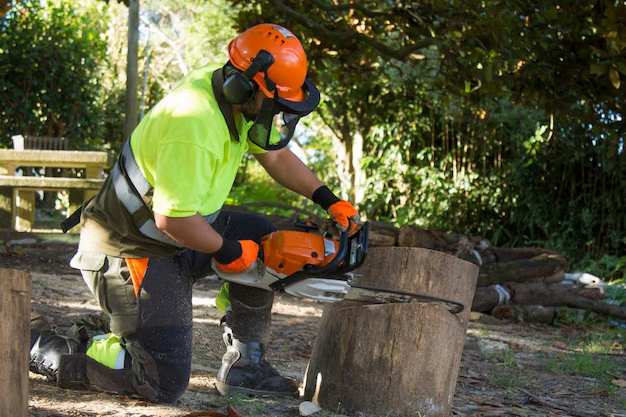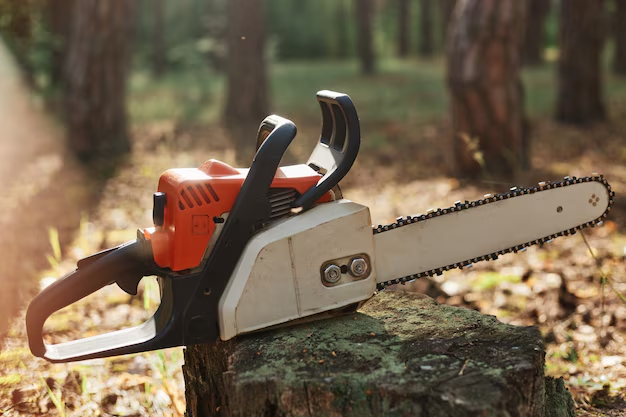Top 5 Chainsaw Hazards and How to Avoid Them
Chainsaws are powerful and versatile tools widely used in forestry, landscaping, construction, and property maintenance. While they can make cutting wood and clearing land easier, chainsaws also pose significant safety risks when used incorrectly. In fact, chainsaw-related injuries are among the most severe in the industry, often resulting in deep lacerations, fractures, and even fatalities. Proper knowledge, training, and the right equipment are essential to ensuring safety for operators and those nearby.
Southbrook Safety & Consulting Ltd. is committed to promoting safe practices in hazardous environments, offering specialized training and certifications to minimize risks. This article explores the top five chainsaw hazards and provides actionable safety measures to help you avoid accidents, making chainsaw safety a top priority for professionals and DIY users alike.
For more information on comprehensive chainsaw training programs, visit Southbrook Safety & Consulting Ltd. or explore our chainsaw certification courses in Alberta.
Understanding Chainsaw Safety
Chainsaw safety is more than just wearing protective gear. It involves understanding the mechanics of the tool, recognizing hazards in your work environment, and being mindful of proper handling techniques. Even experienced users benefit from refresher courses to ensure they stay current with best practices.
A chainsaw’s high-powered motor, sharp chain, and kickback potential make it one of the most dangerous tools in forestry and landscaping. According to studies, thousands of chainsaw-related injuries occur annually, many of which could be prevented with the right precautions. Organizations like Southbrook Safety & Consulting Ltd. help individuals and companies reduce these risks through targeted training, safety consulting services, and certification programs.
Before diving into the hazards, let’s review the fundamental principles of safe chainsaw operation:
- Always wear certified personal protective equipment (PPE).
- Inspect your chainsaw and maintain it regularly.
- Maintain a stable stance and a clear cutting area.
- Use proper grip and cutting techniques.
- Complete recognized chainsaw certification programs.
Common Chainsaw Hazards and Risk Levels
| Hazard | Risk Level | Common Causes | Safety Measures |
| Kickback | High | Chain pinching, improper positioning | Proper grip, chain brake, reduced-kickback bar |
| Chain Contact | High | Improper handling, poor PPE | PPE, safety training, steady positioning |
| Vibration Injuries | Medium | Prolonged use, poor ergonomics | Anti-vibration gloves, breaks, ergonomics |
| Noise-Induced Hearing Loss | Medium | Loud engine noise | Hearing protection, maintenance |
| Falling Debris or Logs | High | Poor planning, environmental hazards | Pre-cut planning, communication, PPE |
1. Kickback: The Most Dangerous Chainsaw Hazard
Kickback occurs when the upper tip of the chainsaw bar makes sudden contact with wood or another object, causing the saw to jerk backward toward the operator. This hazard is one of the most common causes of severe chainsaw injuries, particularly head and upper-body injuries. Kickback happens in a split second, leaving no time to react without training.
To minimize the risk of kickback, it is essential to:
- Use chainsaws equipped with chain brakes and reduced-kickback guide bars.
- Maintain a firm two-handed grip and balanced stance while operating.
- Avoid cutting with the tip of the chainsaw bar whenever possible.
- Regularly sharpen the chain to reduce binding and pinching.
Chainsaw certification courses, like those offered by Southbrook Safety & Consulting Ltd., provide hands-on instruction to help users handle kickback safely.
2. Direct Contact with the Chain
The chainsaw’s cutting chain moves at speeds up to 60 miles per hour, making even a brief touch extremely dangerous. Direct contact often occurs when users lose control, operate the tool improperly, or neglect safety protocols.
Best practices to avoid this hazard include:
- Always engaging the chain brake before moving or adjusting the chainsaw.
- Wearing protective chaps, gloves, and boots to reduce injury severity.
- Maintaining a stable footing and clear cutting path.
- Practicing safe starting techniques, such as placing the saw on the ground before pulling the starter cord.
Southbrook Safety & Consulting Ltd. emphasizes that even seasoned operators should review these steps regularly. Visit our website to learn about PPE requirements and other safety resources.
3. Vibration-Related Injuries
Prolonged use of chainsaws can lead to conditions like Hand-Arm Vibration Syndrome (HAVS) or carpal tunnel syndrome, caused by repeated exposure to intense vibrations. Symptoms include tingling, numbness, and reduced grip strength, which can compromise long-term safety and productivity.
To reduce the risk of vibration-related injuries:
- Use chainsaws with built-in anti-vibration features.
- Wear anti-vibration gloves and take frequent breaks.
- Keep your body relaxed and avoid gripping the tool too tightly.
- Rotate tasks to limit exposure to prolonged vibrations.
Southbrook Safety & Consulting Ltd. offers training that highlights proper ergonomics, ensuring workers remain safe and healthy on the job. Learn more through our safety consulting services.
4. Noise-Induced Hearing Loss
Chainsaws produce sound levels above 100 decibels, well beyond safe thresholds for prolonged exposure. Without adequate hearing protection, operators risk permanent hearing loss over time.
To safeguard your hearing:
- Always wear ear defenders or high-quality earplugs.
- Regularly inspect and maintain your chainsaw to reduce noise levels.
- Limit continuous use and take hearing breaks where possible.
- Use chainsaws designed with noise-reduction technology.
For organizations managing forestry or landscaping crews, Southbrook Safety & Consulting Ltd. offers training and risk assessments to improve workplace safety culture. Explore our consulting solutions to ensure your team’s safety.

5. Falling Debris and Environmental Hazards
Chainsaw work often involves cutting branches, trees, and logs, increasing the risk of falling debris. Unstable terrain and weather conditions further add to the dangers. Without proper planning, serious injuries can occur.
Mitigation strategies include:
- Surveying the worksite for potential hazards before cutting.
- Establishing a safe escape route when felling trees.
- Communicating effectively with coworkers to avoid positioning risks.
- Wearing hard hats, boots, and protective eyewear.
Southbrook Safety & Consulting Ltd. emphasizes pre-cut planning in its certification programs, equipping operators with the skills to assess and control environmental risks effectively.
Importance of Chainsaw Training and Certification
Chainsaw safety is not just about avoiding injury—it’s also about complying with occupational health and safety standards. Many regions, including Alberta, require operators to undergo certification for chainsaw use in professional settings. Certification demonstrates competence, ensures adherence to regulatory requirements, and builds confidence among employers and employees.
Southbrook Safety & Consulting Ltd. provides chainsaw certification courses in Alberta that cover:
- Chainsaw operation fundamentals.
- Maintenance techniques.
- Risk assessment and hazard mitigation.
- Emergency response protocols.
Practical Chainsaw Safety Tips
Whether you’re a professional arborist or a homeowner, these practical tips can help reduce your risk:
- Conduct a pre-operation inspection of your chainsaw before every use.
- Clear your work area of debris, obstacles, and bystanders.
- Keep a first aid kit nearby for emergencies.
- Follow manufacturer instructions for chainsaw maintenance.
- Never operate a chainsaw when fatigued or impaired.
For personalized safety advice and training, reach out to Southbrook Safety & Consulting Ltd. via our contact page.
Benefits of Implementing Safety Programs
Investing in comprehensive chainsaw safety programs has several advantages for both individuals and organizations:
- Reduced injury rates: Proper training significantly decreases accidents.
- Increased productivity: Operators work more efficiently when confident in their skills.
- Regulatory compliance: Certification ensures you meet workplace safety standards.
- Cost savings: Fewer injuries lead to lower compensation claims and downtime.
To create a safer work environment, companies can partner with Southbrook Safety & Consulting Ltd. for ongoing safety education and consulting services.
Conclusion
Chainsaws are indispensable tools, but their potential for harm cannot be underestimated. By understanding hazards like kickback, chain contact, vibration injuries, hearing loss, and falling debris, operators can take steps to protect themselves and others. Training and certification through Southbrook Safety & Consulting Ltd. empower individuals with the knowledge and confidence to operate chainsaws safely.
Making chainsaw safety a priority is not just about preventing injuries—it’s about creating a culture of responsibility, compliance, and professionalism. Start your journey toward safer practices by visiting Southbrook Safety & Consulting Ltd. today.
Frequently Asked Questions (FAQ)
1. Why is chainsaw certification important?
Chainsaw certification demonstrates that an operator has the skills and knowledge to use the tool safely, reducing workplace risks. In many areas, certification is also required to meet legal and regulatory standards. Learn more about certification here.
2. What PPE is essential for chainsaw use?
Key PPE includes chainsaw chaps, steel-toed boots, gloves, a helmet with a face shield, and hearing protection. Southbrook Safety & Consulting Ltd. emphasizes PPE in all training programs.
3. How often should I service my chainsaw?
Routine maintenance is critical. Inspect and sharpen your chain regularly, check fluid levels, and ensure safety features are working. Explore more safety tips on our website.
4. Can chainsaws cause long-term health problems?
Yes. Prolonged exposure to vibrations and noise can lead to chronic conditions like HAVS and hearing loss. Proper equipment and training minimize these risks.
5. Where can I get professional chainsaw safety training in Alberta?
Southbrook Safety & Consulting Ltd. offers chainsaw certification in Alberta and a variety of workplace safety programs. Contact us here to enroll.

